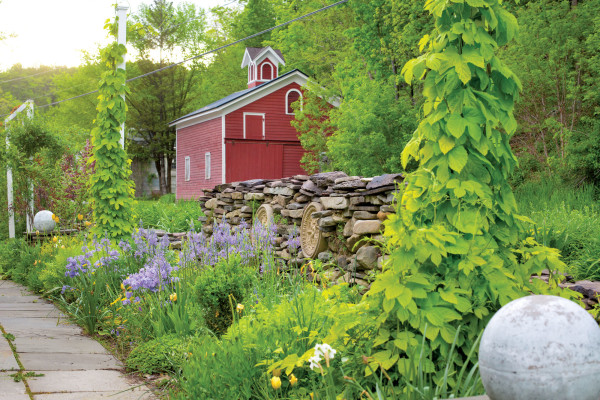
In the roadside bed, golden hops are interplanted on tall poles with Clematis viticella ‘Polish Spirit’ to provide a long season. Hops reference the agricultural history of the area. A “borrowed view” of the neighbor’s red barn is backdrop.
Gross & Daley
In 2011, disaster struck again as Hurricane Irene caused creeks to rise, inundating village homes. Moving water knocked down the renovated carriage barn, carried fallen trees perilously close to the house, and left up to 30 inches of sandy silt behind. The house needed emergency renovation, the garden a do-over.
When Steve Whitesell discovered the hamlet of North Blenheim, in 2009, the area was between disasters. The small village is alongside the Schoharie River in a narrow valley in Upstate New York. In the late 20th century, 25 Greek Revival homes here survived and were listed on the National Register of Historic Places. The first disaster came in 1990, when many of the town’s pre-Civil War houses were leveled by a fireball that erupted from a gas-pipeline explosion, sending flames 60 feet and setting fire to treetops.
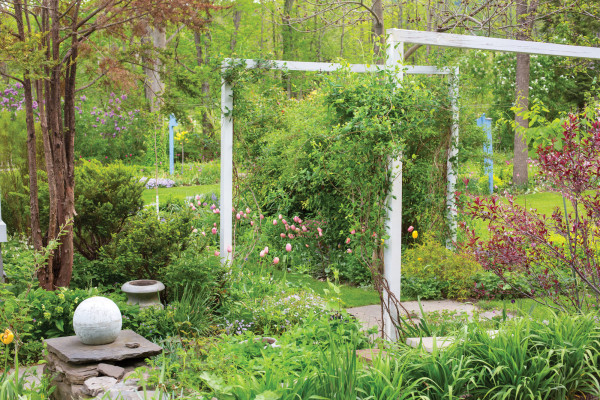
On the west side of the garden, two white arches support the honeysuckle vine Lonicera sempervirens ‘John Clayton’.
Gross & Daley
One of the Greek Revival houses spared from the fire belonged to an elderly woman who grew red tulips alongside a white picket fence. Hers was the house that Whitesell, a licensed landscape architect, bought in 2009. Living in New York City, working for the Parks Department, Steve had been searching for a farmhouse not too far from the city, where he could do some weekend gardening. This ca. 1835 house, which came with a small carriage shed, was on one-third of an acre and afforded views of neighboring barns, fields, and mountains. “I liked that there was a good, level garden area with rich soil,” Steve says, “large enough to do something interesting, but still manageable.”
The garden is a Colonial Revival interpretation. “My clients want low maintenance,” says the designer, “but taking care of my borders is fun for me; the formal structure gives me a sense of calm.”
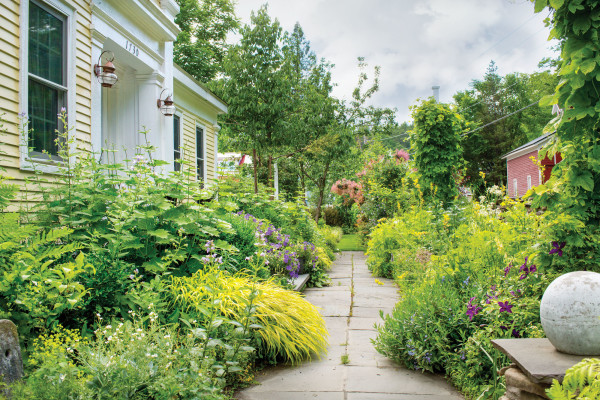
A paved walkway of locally quarried bluestone now runs in front of the house. The double border has golden grass, Amsonia ’Blue Ice’, and Kirengeshoma palmata from Japan.
Gross & Daley
He began working on his garden design, elaborating on the existing cottage garden that had run a little wild. Establishing axes and creating green-lawn “runner paths” and “area rugs,” Steve aimed to create “an orderly plan with structure and a clear, rational circulation system.” He cut down some scrubby trees to open up the space. Down came some old peaches infected with borers, and a plum that had succumbed to an ice storm during Steve’s first winter here. He put in double perennial borders with hues of blue, purple, pink, garnet red, and yellow, backed with hardy English boxwood.
Only two years later, disaster struck again. A catastrophic flood due to Hurricane Irene in 2011 caused the creeks to rise more than 20 feet, inundating village homes and sweeping away the famous Blenheim Covered Bridge. The moving water knocked down Steve’s newly renovated carriage barn, which ended up overturned in the neighbor’s yard. Up to 30 inches of sandy silt was left behind when floodwaters receded. Several large, uprooted trees had floated into Steve’s yard, and narrowly missed crashing into the house.
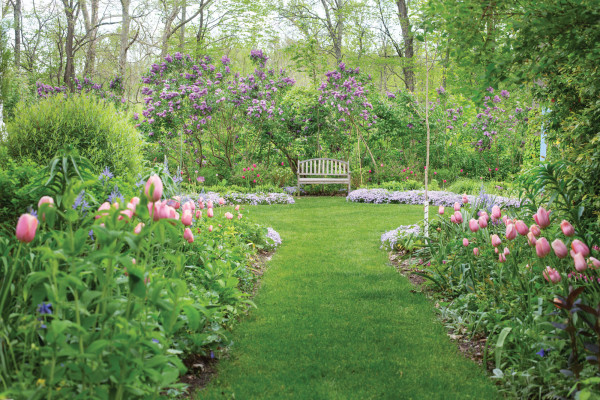
A circular lawn area edged in lavender creeping phlox forms the center of this garden, where two main paths cross. The pink tulip is ‘Menton’.
Gross & Daley
Now his house needed emergency renovation, and Steve also faced the grueling labor of starting over in the garden. He moved about 100 wheelbarrow loads of silt to reduce sandbars, level drifts, and fill scoured, sunken areas. “Miraculously,” he says, “many plants survived to grow back.” Twin urns he’d placed by his freshly painted front door were intact after the hurricane. “Although they were underwater, they weren’t even knocked off their pedestals.”
The white picket fence was washed away, but Steve admits he’d never really liked it. “I’d painted it a month or so before the flood, and I didn’t ever want to do it again.” He had already begun to replace it with a dry-laid stone wall, using stones brought in by cart from old, tumbledown walls enclosing a neighbor’s field.
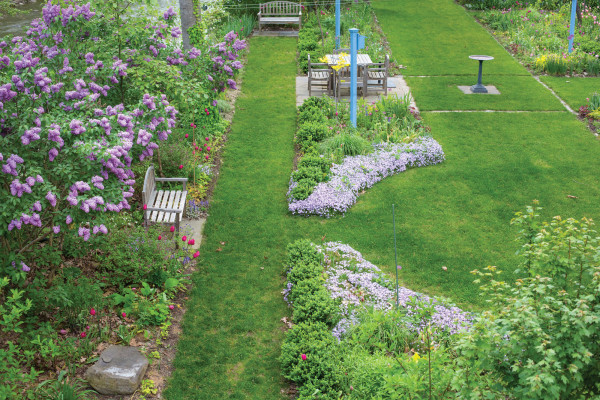
Fragrant lilacs already on the property thrive alongside the creek. A small birdbath centers a garden divided into rooms and corridors, with lawn “runners” and “area rugs.”
Gross & Daley
The smashed carriage barn was replaced with a small building Steve designed to serve as a garage with a studio/summer bedroom and balcony above. “I’d finished renovating the carriage shed the day before the flood,” he says. “Its replacement has a ground floor of concrete block, filled with reinforcing bars that tie the walls to the thick floor slab; it’s built like a bunker and shouldn’t budge in any future flood.”
The house next door was abandoned after the flood, and Steve was able to acquire it and its acreage to double the size of his garden. The biggest challenge has been bringing in all the reconstruction materials; dozens of truckloads of stone and soil and thousands of plants were used to create what is a relatively small garden. “Though the garden will never be finished, most of the heaviest work is done now. When I hit my 50s, I realized I’d better get to work before I started to fall apart,” he laughs.
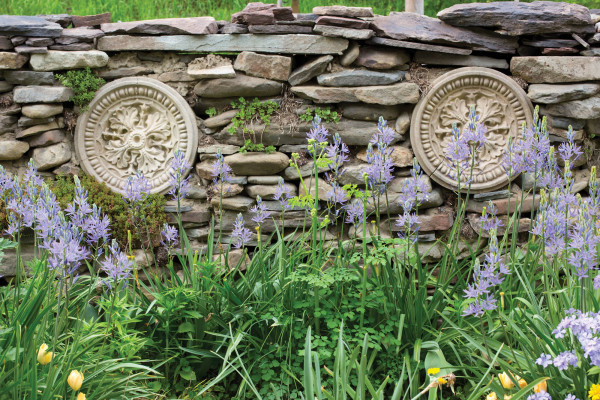
Decorative cast-stone roundels were inserted into the wall as Steve Whitesell built it.
Gross & Daley
Today, Steve Whitesell lives in Blenheim full time, his postdiluvian garden a bit of paradise regained. Steve has placed wooden benches and a dining table under an umbrella, “but I don’t really use them that much,” he says. “Whenever I sit down, I see something that needs weeding, and I get back to work.”
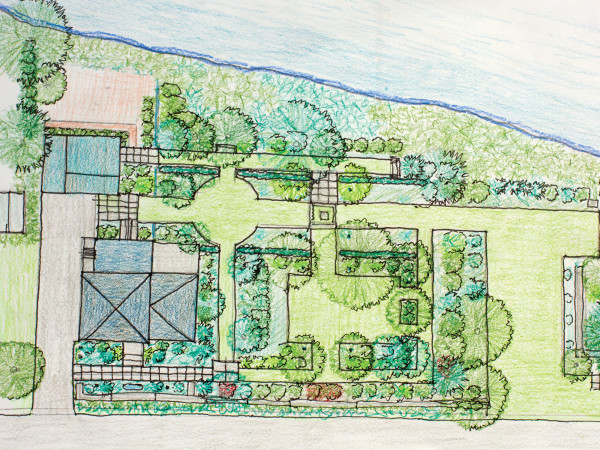
To the west of the house, a quadrangle is bordered by shrubs and ornamental trees.
Gross & Daley
The Garden Plan
“I wanted to keep the view of the creek open,” says Steve Whitesell. “I also wanted to create a fairly formal layout to complement the house, with double herbaceous borders, crossed axes, and dense planting with variety to gain a long bloom period.” The circular lawn section is backed by a double line of hardy English boxwood Buxus sempervirens ‘Vardar Valley’, which provides evergreen structure in winter. To the west of the house, a quadrangle is bordered by shrubs and ornamental trees.







